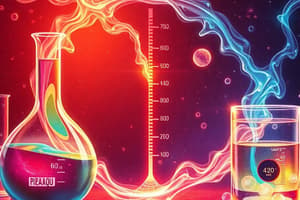Podcast
Questions and Answers
Pure water has a pH of 8, which categorizes it as slightly basic.
Pure water has a pH of 8, which categorizes it as slightly basic.
False (B)
Lemon juice has a pH value of 2-3, indicating it is highly alkaline.
Lemon juice has a pH value of 2-3, indicating it is highly alkaline.
False (B)
Buffer solutions are capable of resisting changes in pH when acids are added.
Buffer solutions are capable of resisting changes in pH when acids are added.
True (A)
A pH meter and pH test strips provide equally precise measurements of pH.
A pH meter and pH test strips provide equally precise measurements of pH.
Soil health monitoring is important because the optimal pH affects nutrient availability.
Soil health monitoring is important because the optimal pH affects nutrient availability.
Increased temperature can lead to lower pH readings.
Increased temperature can lead to lower pH readings.
The pH of baking soda is between 8-9, categorizing it as acidic.
The pH of baking soda is between 8-9, categorizing it as acidic.
RMC likely refers to a theory related to pH measurement only in agricultural practices.
RMC likely refers to a theory related to pH measurement only in agricultural practices.
Flashcards are hidden until you start studying
Study Notes
pH RMC 5-2024
-
Definition of pH:
- pH is a measure of the acidity or alkalinity of a solution.
- Scale ranges from 0 (acidic) to 14 (alkaline), with 7 being neutral.
-
Importance of pH:
- Affects chemical reactions, biological processes, and the solubility of compounds.
- Critical in fields like agriculture, environmental science, medicine, and food production.
-
pH Measurement:
- Measured using pH meters, pH test strips, or indicators.
- pH meters provide precise measurements; test strips are more practical for quick tests.
-
Factors Affecting pH:
- Concentration of hydrogen ions (H⁺).
- Presence of acids (lower pH) or bases (higher pH).
- Temperature can influence pH readings.
-
Applications of pH:
- Soil health monitoring for agriculture; optimal pH is crucial for nutrient availability.
- Water quality assessment; specific pH ranges are required for aquatic life.
- Food and beverage industry; certain products require specific pH for taste and preservation.
-
RMC Context:
- RMC likely refers to a specific research or regulatory framework related to pH standards or practices.
- May involve guidelines for maintaining pH levels in various systems or industries.
-
2024 Focus:
- Expected advancements or updates in pH measurement technology.
- Regulatory changes or new best practices for pH management.
- Emphasis on sustainable practices in industries relying on pH control.
-
Key Terms:
- Acid: Substances that donate protons (H⁺) and have a pH less than 7.
- Base: Substances that accept protons and have a pH greater than 7.
- Buffer Solutions: Mixtures that resist changes in pH when acids or bases are added.
-
Common pH Values:
- Pure water: 7 (neutral)
- Lemon juice: 2-3 (acidic)
- Baking soda: 8-9 (basic)
- Sea water: 7.5-8.5 (slightly basic)
-
Monitoring pH:
- Regular testing recommended in agriculture (crop yield) and aquaculture (fish health).
- Adjustments may be necessary based on pH readings, employing lime (to raise) or sulfur (to lower).
-
Future Directions:
- Research into automated pH monitoring systems.
- Development of more efficient buffering agents.
- Focus on environmental impact assessments related to pH fluctuations.
pH: A Comprehensive Overview
- pH scale ranges from 0-14, indicating acidity (0-6), neutrality (7), and alkalinity (8-14).
- pH influences numerous chemical reactions, biological processes, and compound solubility. It's vital across many fields.
- Accurate pH measurement is achieved using pH meters; quicker estimations use pH test strips or indicators.
Factors Affecting pH
- Hydrogen ion (H⁺) concentration is the primary determinant.
- Acids increase H⁺, lowering pH; bases decrease H⁺, raising pH.
- Temperature can slightly alter pH readings.
pH Applications
- Agriculture: Soil pH directly affects nutrient availability and crop yield. Optimal pH is crucial.
- Environmental Science: Water pH is critical for aquatic life; variations impact ecosystems.
- Food and Beverage Industry: Specific pH levels are crucial for taste, preservation, and food safety.
RMC 5-2024 Context
- Likely refers to a regulatory framework or research initiative focusing on pH standards and best practices.
- Anticipates advancements in pH measurement technologies, regulatory updates, and sustainable pH management by 2024.
Key Concepts and Definitions
- Acids: Donate H⁺ ions, pH < 7.
- Bases: Accept H⁺ ions, pH > 7.
- Buffer Solutions: Resist pH changes when acids or bases are added.
Common pH Values
- Pure water: 7
- Lemon juice: 2-3
- Baking soda: 8-9
- Seawater: 7.5-8.5
pH Monitoring and Future Trends
- Regular pH testing is recommended in agriculture (for optimal crop yields) and aquaculture (for fish health).
- Lime and sulfur can adjust soil pH; lime increases it, sulfur decreases it.
- Future research includes automated pH monitoring systems, improved buffering agents, and environmental impact assessments related to pH fluctuations.
Studying That Suits You
Use AI to generate personalized quizzes and flashcards to suit your learning preferences.




